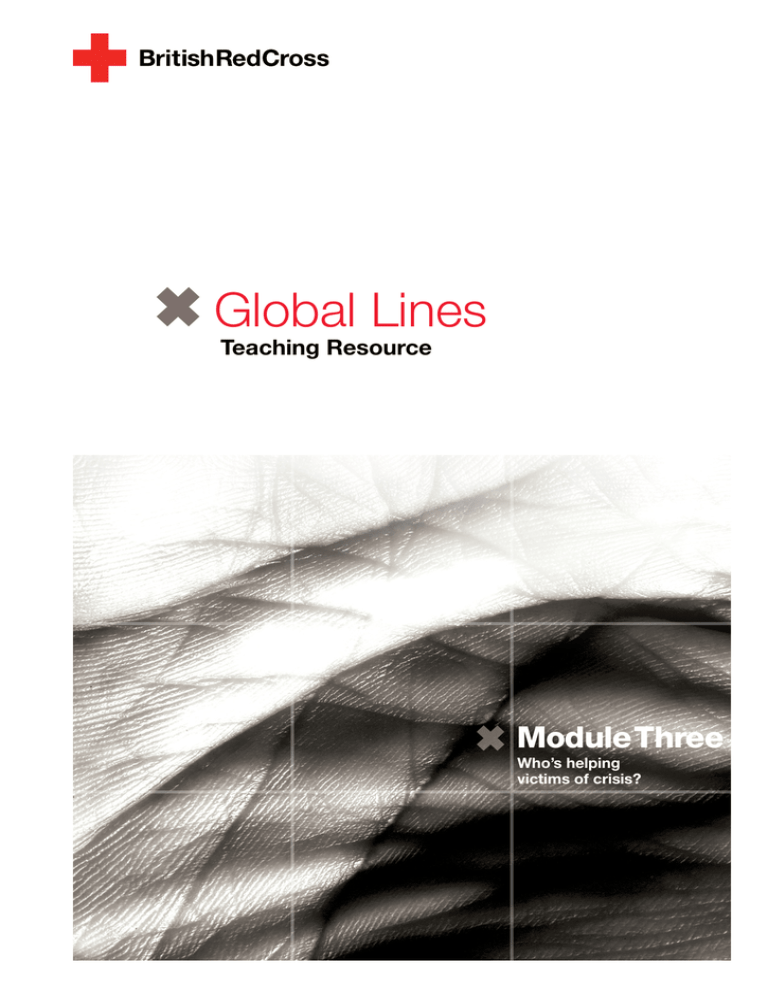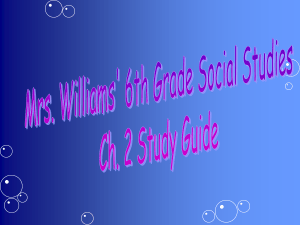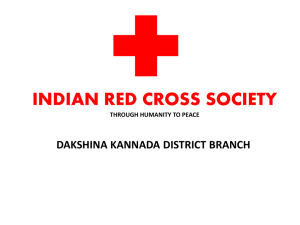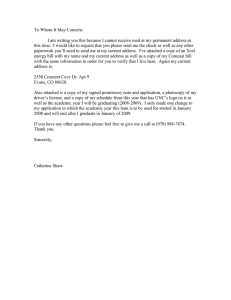Global Lines Module Three Teaching Resource Who’s helping
advertisement

Global Lines Teaching Resource Module Three Who’s helping victims of crisis? Global Lines Module Three Contents Module Three Contents 3.1.0 Activity one - Countries affected by crisis Requires: Photo packs 2 and 3 from Module 1 (1.2.1 and 1.3.1) Peters Projection World Map from Module 2 3.2.0 Activity two - Responding to crises and assessing humanitarian needs 3.2.1 Poster – can be downloaded and displayed on an interactive whiteboard. 3.2.2 Information cards – to be printed and handed out. 3.2.3Priority Chart – can be projected onto an interactive whiteboard. Active fields under each heading allows additional material to be added. 3.3.0 Activity three - What can I do? redcross.org.uk/globallines | 2 Global Lines Module Three Introduction Module Three Who’s helping victims of crisis? This module highlights crises from around the world and looks at what can be done to tackle them. It’s designed to raise awareness of the different types of crisis and give students an idea of the type of aid victims of crisis need. It also shows how difficult it is for humanitarian organisations to meet all the needs of every country facing a crisis. Once students have understood the concept of crisis and how it is affecting countries around the world, they’ll be encouraged to extend the exercise and do something positive in their own community. They can get their family and friends involved, shared what they’ve learned and perhaps help vulnerable groups or people in their local area. Crisis response These activities should give students a better understanding of the different types of crisis, where they are occurring around the world and what can be done about them. Once students have completed the exercises: >all will know something about the role of the Red Cross in crisis response around the world >most will begin to understand that the Red Cross Movement has to prioritise its crisis response efforts according to the needs of victims >some will carry out further research and develop a good understanding of how active the Red Cross is, how it is organised and how its fundamental principles are realised redcross.org.uk/globallines | 3 Global Lines Module Three Activity One 3.1.0 Countries affected by crisis Teacher Resource Activity one Countries affected by crisis Resources > W orld map > Photo packs 2 and 3 > Writing board Timing About 55 minutes What to do 1.Divide students into pairs and ask them to jot down at least four countries they feel would be considered to be in a crisis – the supplied map of world might be useful here as well as current newspapers and cuttings. Then ask the following questions: > What is crisis? > Where do crises occur? > What is the difference between a man-made and a natural crisis? Ask the pairs to join up with other pairs to form two large groups in which they can repeat the process. Each group should nominate a writer. 2. While the groups are discussing their answers, write these phrases on the board COUNTRIES IN CRISIS TYPE OF CRISIS (man-made or natural) 3.Ask the writer from each group to come up to the board and write down three of the countries their group thought of and the type of crisis those countries are facing. 4.Then ask each student to choose a photograph from photo pack 2 or 3 and make a list of the needs that they think the people who lived through the situation in the photograph would have. redcross.org.uk/globallines | 4 Global Lines Module Three Activity One 3.1.0 Countries affected by crisis Teacher Resource Activity one (continued) Countries affected by crisis 5.When they’ve done that, ask them to get into small groups of two or three and discuss the pictures they chose, focusing on: > the resources that have been destroyed or lost > the humanitarian needs they listed and why. sk them to note not only highly visible damage, such as destroyed buildings, but A other types of damage too, such as damage to utilities, to personal belongings, death and separation of family members, and loss of community services. 6.Finally, bring the class back together to compile a list of the resources that can be destroyed through conflict or natural disaster and a list of the needs that result from those losses. These questions might come in useful during the discussion: > What further losses will people have as a consequence of the destroyed resources? > Which groups generally deserve special attention in such emergencies? Why? Conclusions > C risis results in a tremendous loss of resources and disrupts infrastructure > When crisis breaks out, life and human dignity become vulnerable and need special protection > The task of repairing the infrastructure requires the joint efforts of numerous humanitarian agencies redcross.org.uk/globallines | 5 Global Lines Module Three Activity Two 3.2.0 Responding to crises and assessing humanitarian needs Teacher Resource Activity Two Responding to crises and assessing humanitarian needs Resources > W orld map > Poster – a collage of images depicting Red Cross and Red Crescent activities (to be > > > > > printed). This can also be downloaded and projected onto a whiteboard for class use. Information cards on the International Red Cross and Red Crescent Movement and its Fundamental Principles Internet access Blank card / paper divided into sections or a number of sticky notes for each group. Scissors Priority chart (to be printed A3). This can also be downloaded and projected onto an interactive whiteboard for class use. Active fields under each heading allow additional material to be added. Timing About 40 minutes What to do 1.Divide the students into three different country groups. Using the world map from module two, ask the groups to list what the aid or development needs of that country might be. 2.Bring the class back together to look at the lists they have put together. Ask them to think about assumptions they might have made or key needs that may have been missed. These questions might help to steer the discussion in the right direction: > What are the basic needs of people in crisis? > Are some needs more important than others? > Will everyone in the country have the same needs? If not, why not? 3.Display the collage poster and distribute (printouts of) the information cards. Distribute (A3 printouts of) the priority chart to each group. Ask students to get back into the same three groups and look at the poster and read the cards. They then write down as many things as possible to describe what the Red Cross and Red Crescent does, putting each one in a blank square on the sectioned paper (and cut them out to form separate cards) or write them on separate sticky notes. You might like them to consider these questions: > From looking at the structure and the worldwide presence of the Red Cross and Red Crescent Movement, what do you think are its particular strengths? > What needs does the Red Cross and Red Crescent not meet and why? > What are the main obstacles in providing effective humanitarian assistance to victims of crisis? redcross.org.uk/globallines | 6 Global Lines Module Three Activity Two 3.2.0 Responding to crises and assessing humanitarian needs Teacher Resource Activity Two (continued) Responding to crises and assessing humanitarian needs 4.Ask the students to place the cards listing Red Cross and Red Crescent activities in order of priority on the priority chart, bearing in mind the particular needs of the country they have been learning about. They should explain their choices to the whole group. This could lead to a discussion about what the most important human needs are and why the concept of impartiality is so important to the Red Cross. Your students could consider these kinds of questions: > Do different National Red Cross and Red Crescent Societies have different priorities? Why? > Thinking about the areas you have studied, how easy or difficult do you think it would be to stay true to the Red Cross and Red Crescent Movement’s fundamental principles of being impartial, neutral and independent during those crisis situations? Extending the activity – group discussion A: What are our essential needs? > > > > > ake a list of the things you need in order to live in reasonable comfort? M Circle the ones that you think are absolutely essential to living a normal life Now mark the ones that you consider your human dignity to depend on How do you think these needs would be affected by a crisis? Compare your list to other people’s B: The experience of fleeing When people are plunged into crisis they sometimes have to flee their homes, suffering a loss of shelter, possessions, water, electricity, work and education. They often don’t know how long they will be away or even if they will ever return. In a small group, imagine the following situation: > You are a family or group of neighbours. > Your home and area are under devastating attack. > You must leave now in order to save your lives. > You do not know where you will be going and whether you will be able to return. > You have only ten minutes. 1. Individually, write down what you want to take. 2. Then, as a group, decide what you can actually take, why you want to take it and how to carry it. redcross.org.uk/globallines | 7 Global Lines Module Three Activity Two 3.2.0 Responding to crises and assessing humanitarian needs Teacher Resource Activity Two (continued) Responding to crises and assessing humanitarian needs 3. Write down the group’s plans. Compare your group’s plan with the others’. > What did your group take and why? > What thoughts or feelings did you have as you made these decisions? > What difference would it make if your group included elderly people or infants? > How would the chaos of armed conflict affect your decisions? C: Who responds in a crisis? There are a whole range of humanitarian organisations who respond to crises around the world. Besides the Red Cross and Red Crescent, there are the different United Nations organisations such as UNICEF, UN High Commission for Refugees and the World Food Programme, international organisations such as Médecins sans frontières, Human Rights Watch and Save the Children, and many local organisations. 1.Divide students into small groups and ask them to list the needs of people affected by crisis. 2.Then ask them to list the kind of humanitarian aid provided by the organisations above (allow five minutes for this). 3.Bring the class back together to share ideas. You might want your students to consider what difficulties humanitarian organisations encounter in their work and why. Things like lack of funds, security problems, the problems of helping people trapped in a war zone or mixed in with armed combatants, diplomatic problems hindering relief convoys or simply the overwhelming scale of the problem. 4.Ask the students to think about the precautions that should be taken when planning or acting in a range of humanitarian emergencies. For example, careful assessment to ensure that people are helped according to their needs and that they will not become dependent on the assistance. Also, planning so as to cover the most urgent needs and to address root problems first (e.g. before bringing dry food, check the available means to cook it), checking the quality of water to avoid an epidemic and using local experts whenever possible. Your students can use the information cards on the International Red Cross and Red Crescent Movement for more background. redcross.org.uk/globallines | 8 Global Lines Module Three Activity Two 3.2.1 The Red Cross & Red Crescent Movement in action Student Resource Poster The Red Cross & Red Crescent Movement in action The Red Cross & Red Crescent Movement in action redcross.org.uk/globallines | 9 1 2 3 Nations adopted the red crystal emblem to increase protection for authorised personnel in situations where the existing emblems would not be respected and to promote the universality of the Red Cross and Red Crescent Movement. *An additional protective emblem – the red crystal – was established in 2005. It has equal status and meaning to the red cross and red crescent emblems. 1National Red Cross & Red Crescent Societies* 2 The Icrc 3 The Federation The two international institutions are the International Committee of the Red Cross (ICRC) and the International Federation of Red Cross and Red Crescent Societies (the Federation). The National Societies embrace most of the more than 97 million Red Cross and Red Crescent workers - the world’s biggest volunteer force. “The Movement” is a term covering two international institutions with headquarters in Geneva and National Societies in over 186 countries. The ICRC was established in 1863 and is the founding body of the Red Cross Movement. It is a neutral, impartial and independent organisation; this means that it can work world-wide and act as a humanitarian mediator on all sides in a conflict. The Red Cross and Red Crescent on a white background are among the world’s most enduring images. In war and peace, and in the midst of suffering and tragedy caused by man-made or natural disasters, they are internationally recognised symbols of help and compassion. It has also an important role in promoting and strengthening international humanitarian law and universal humanitarian principles. The ICRC’s mission is to protect the lives and dignity of victims of war and internal violence and to provide them with assistance. It manages and coordinates international relief activities in situations of conflict. The International Comittee of the Red Cross The Red Cross and Red Crescent Movement Global Lines Module Three Activity Two 3.2.2 About the Red Cross & Red crescent Student Resource Information cards About the Red Cross & Red crescent redcross.org.uk/globallines | 10 Nations adopted the red crystal emblem to increase protection for authorised personnel in situations where the existing emblems would not be respected and to promote the universality of the Red Cross and Red Crescent Movement. *An additional protective emblem – the red crystal – was established in 2005. It has equal status and meaning to the red cross and red crescent emblems. They also support the work of the Red Cross and Red Crescent Movement internationally. Likewise, all Red Cross and Red Crescent activities have a central purpose - to help without discrimination those who suffer, thus contributing to peace in the world. The Movement is guided by the seven fundamental principles: humanity, impartiality, neutrality, independence, voluntary service, unity and universality. >P roviding and coordinating humanitarian relief programmes outside conflict areas >A ssisting the development of National Societies >C oordinating the work of Red Cross and Red Crescent National Societies world-wide The Federation aims to assist the world’s most vulnerable people. Funded by appeals, its activities focus on health, disaster response and disaster preparedness. The Federation’s work includes: The International Federation was created in 1919 and is the world’s largest humanitarian organisation, with over 186 member National Red Cross or Red Crescent Societies. There are Red Cross and Red Crescent Societies in virtually every country around the world. The National Societies provide for the needs of the population in their own countries and provide a range of humanitarian services ranging from first aid training, health and social assistance to disaster relief. More information about the British Red Cross can be found at www.redcross.org.uk International Federation of Red Cross and Red Crescent Societies National Red Cross and Red Crescent Societies* Global Lines Module Three Activity Two 3.2.2 About the Red Cross & Red crescent Student Resource Information cards About the Red Cross & Red crescent redcross.org.uk/globallines | 11 This is done by limiting means and methods of warfare to reduce unnecessary suffering and to protect those who do not or are no longer taking part in the fighting. However, wars still happen and so there are other international agreements to try to limit the suffering caused by war. International humanitarian law contains rules which, in times of armed conflict, seek to protect life and human dignity. All the work of the Red Cross Movement is based and guided by seven principles: Except in circumstances where a country is being attacked or is threatened with attack, the Charter of the United Nations outlaws war. 7 UNIVERSALITY – the Movement is worldwide and each National Society is an equal member of the Movement. 6 UNITY – there can only be one Red Cross or Red Crescent Society in each country and it must be open to all. 5 VOLUNTARY SERVICE – the services provided by the Movement are not based on personal gain. 4 INDEPENDENCE – whilst the National Societies may work together with governments, they must always remain separate from them and be able to decide their own actions in accordance with the principles. 3 NEUTRALITY – the Red Cross does not take sides during a conflict, and never gets involved in political, religious or ideological debates. 2 IMPARTIALITY – people are helped regardless of their race, nationality, political beliefs, class or any other feature of their background; they are helped purely on the basis of their need and priority is given to the most urgent cases. 1 HUMANITY – the International Movement acts to prevent and alleviate human suffering, wherever it may be found. Its purpose is to protect life and health and to ensure respect for the human being. Seven principles International Humanitarian Law Global Lines Module Three Activity Two 3.2.2 About the Red Cross & Red crescent Student Resource Information cards About the Red Cross & Red crescent redcross.org.uk/globallines | 12 Global Lines Module Three Activity Two 3.2.3 Responding to crises and assesing humanitarian needs Student Resource Priority Chart Desirable Work Important Work Essential Work Name of Country Note: Please print this is A3 format if possible. redcross.org.uk/globallines | 13 Global Lines Module Three Activity Three 3.3.0 ‘What can I do?’ Teacher Resource Activity Three ‘What can I do?’ Community action projects This final activity is designed to help students turn theory into practice. It will give them a chance to apply something of what they have learned to plan a project that promotes humanitarianism and crisis response. Their project should either: > create greater awareness of crisis response, or > address specific humanitarianism needs in their area. Ideas for projects A.Outreach services for younger children and/or community groups (such as story books, comics, short plays, exhibits, presentations, drama, letters to media, radio call-in programmes, handbooks) B.Volunteering, perhaps as an aid to the homeless, refugees, asylum seekers, displaced persons, orphans, the sick or the elderly C.Research-to-action – researching crisis needs and crisis response or joining a humanitarian or human rights organisation Preparing to work in the community It’s vitally important that students fully understand the community they want to help. The Red Cross have a set of community aid guidelines that should help them do that - they relate specifically to volunteering projects, but can also be applied to outreach or research-to-action projects: 1. Work with people to identify the strengths of their community 2. Work together to identify problems, needs and threats 3.Identify those who are the most in need of support and who are the highest priority, given the available skills and resources 4.Work with the community to improve the situation of the most vulnerable people Ask students to think about the kind of projects that would benefit their community and how local skills and knowledge could be put to good use in those projects. redcross.org.uk/globallines | 14 Global Lines Module Three Activity Three 3.3.0 ‘What can I do?’ Teacher Resource Activity Three (continued) ‘What can I do?’ Conclusions >There are many different things a person can do to actively support a humanitarian activity, and it is best to get involved in projects that draw on your skills and interests. >It is essential to see things from the point of view of the people you are trying to help >Regular reviews are a good way to identify strengths and weaknesses in your project plan, enabling you to improve it as you go along Extending the activity Media research This exercise is all about making the most of the media as a tool for research. 1.First of all, find a news report about a situation where human dignity is at risk, a situation that inspires you to become involved. >What is the situation? 2. If that situation is in your community: >find a newspaper or television channel that provides news about and for that community >list ways that the news sources can help you. 3. If the situation is happening outside your community, perhaps abroad: >find a source of news, background information and a list of groups working on the same problem. List your sources. redcross.org.uk/globallines | 15






